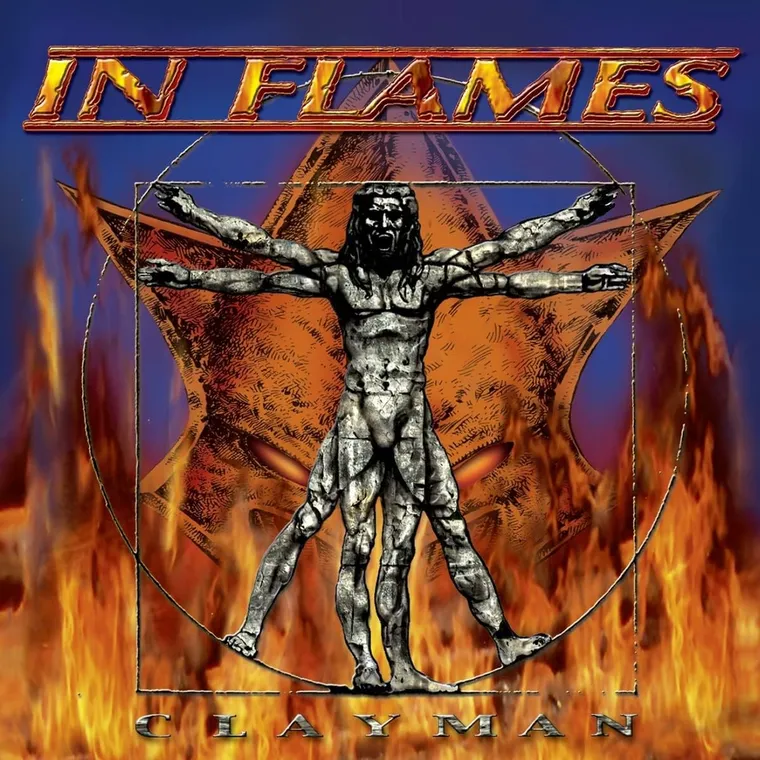Released on July 3, 2000, Clayman is the fifth studio album by In Flames—and it remains one of the most vital and emotionally charged records to ever balance the melodic finesse of Gothenburg death metal with arena-sized hooks and introspective lyricism.
Where their earlier albums forged a path with blistering speed, growled vocals, and labyrinthine riffing, Clayman refines that blueprint into something more accessible without ever losing its teeth. It’s the sound of a band standing at a crossroads—caught between the aggression of their past and the anthemic ambition of their future.
Crafted under the steady production of Fredrik Nordström and the band themselves, Clayman showcases a group firing on all cylinders—tightening their sound, sharpening their focus, and leaning into melody not as a compromise, but as a weapon. It’s an album that’s both polished and feral, soaked in Scandinavian melancholy, and laced with existential dread.
Bullet Ride: The Engine Ignites
The album kicks off with “Bullet Ride,” a mission statement wrapped in chugging riffs and emotionally taut vocals. Anders Fridén, whose growls now flirt with melody, delivers lyrics full of psychological reflection. The song’s surging chorus and twin guitar attack by Jesper Strömblad and Björn Gelotte grab hold immediately—melding speed metal precision with a post-grunge sense of drama. It's an opener that feels urgent, confident, and unmistakably In Flames.
Next, “Pinball Map” dials up the intensity with one of the album’s most infectious riffs. Its lyrics lean toward surreal frustration, but the musicianship stays laser-focused. The dual-guitar harmonies slice through the mix with machine-like clarity, while Daniel Svensson’s drumming keeps everything grounded in momentum and menace. This is a song built for movement—whether in a pit or a solitary drive at 2 a.m.
Sculpting Sorrow into Strength
The title track, “Clayman,” might be the heart of the record. With a chorus that straddles anguish and empowerment, it encapsulates the album’s core themes: identity, fragility, and rebirth. Anders explores the idea of emotional detachment and self-preservation with chilling vulnerability. The songwriting here is lean—tight riffs, crashing rhythms, and melodic leads that elevate the pain rather than obscure it.
Then comes “Only for the Weak,” a track that has since become one of the band’s signature anthems. Its clean guitar intro gives way to a stomping rhythm section and a chorus designed for fists-in-the-air catharsis. There’s a defiant beauty to it—a melodic death metal track that dares to sound uplifting without losing any of its grit.
“...As the Future Repeats Today” further explores Clayman’s lyrical obsessions with time, fate, and inner collapse. The band trades brute force for atmosphere, using subtle electronic textures beneath their guitar lines to create a more immersive soundscape. It’s experimental without being indulgent, proving the band’s maturity.
Twilight of the Mind: A Melodic Descent
The second half of the album continues to evolve. “Swim” stands out with its synth-adorned intro and pummeling rhythm—it feels like a bridge between Colony’s rawer edge and the sleeker ambitions of Reroute to Remain. The track’s layered approach hints at a sonic evolution that wouldn’t fully arrive until later in their discography, but here it feels fresh and purposeful.
“Suburban Me” offers a grimmer, groove-heavy detour. It's a song of resignation and numbness, cloaked in dissonant guitars and subtle programming. “Satellites and Astronauts,” however, is the album’s most surprising turn—a slower, more introspective piece that swaps harsh vocals for an almost spoken-word tone. It’s a bold move, and one that gives Clayman its sense of emotional breadth.
Closer “Another Day in Quicksand” brings the record full circle. It’s fast, melodic, and bitterly self-aware, ending things not with resolution, but with reflection. The chorus burns with frustration, and the final guitar solo feels like the last word in a long, emotionally exhausting conversation.
Production and Performance: Precision Meets Passion
The production on Clayman is crisp without being sterile. Fredrik Nordström and the band strike a balance that many have tried and few have matched: clean enough to showcase the intricacy of the instrumentation, yet raw enough to retain emotional punch.
The twin-guitar work from Strömblad and Gelotte is spectacular throughout—blending Iron Maiden-style harmonies with Swedish melancholy and death metal precision. Peter Iwers’ bass rumbles just beneath the surface, subtly supporting each melodic rise and rhythmic shift. And Svensson’s drumming is the spine of the album—tight, tasteful, and always in service of the song.
Anders Fridén’s vocal performance is particularly notable here. He begins to stretch beyond traditional growls, introducing shouted choruses and emotionally charged phrasings that hint at the broader vocal style he’d develop in later albums. It’s a transitional performance—and one of his most compelling.
Final Verdict: 9/10
Clayman isn’t just a great In Flames album—it’s one of the defining melodic death metal records of its era. It captures a band on the brink of transformation, merging the ferocity of their early years with the emotional and melodic depth that would shape modern metalcore and alt-metal for years to come.
It’s melodic yet aggressive, polished yet raw, and deeply personal without slipping into melodrama. Where many albums from the turn of the millennium feel dated, Clayman still sounds vital—because the questions it asks are timeless.
For longtime fans, it’s sacred ground. For new listeners, it’s the perfect entry point into the evolution of modern metal.
Standout Tracks
- Bullet Ride
- Clayman
- Only for the Weak
- Satellites and Astronauts
- Pinball Map
- Another Day in Quicksand

